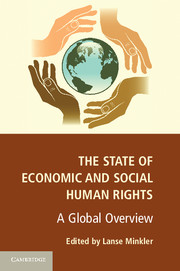Book contents
- Frontmatter
- Contents
- Contributors
- Acknowledgments
- 1 Introduction: Why Economic and Social Human Rights?
- I CORE RIGHTS
- 2 The Right to Food: A Global Perspective
- 3 Globalization and the Right to Health
- 4 Demolishing Housing Rights in the Name of Market Fundamentalism: The Dynamics of Displacement in the United States, India, and South Africa
- 5 Implementation of the Human Right to Social Security around the World: A Preliminary Analysis of National Social Protections Laws
- 6 Why Is the Right to Work So Hard to Secure?
- II NONDISCRIMINATION
- III META
- Index
- References
2 - The Right to Food: A Global Perspective
Published online by Cambridge University Press: 05 February 2013
- Frontmatter
- Contents
- Contributors
- Acknowledgments
- 1 Introduction: Why Economic and Social Human Rights?
- I CORE RIGHTS
- 2 The Right to Food: A Global Perspective
- 3 Globalization and the Right to Health
- 4 Demolishing Housing Rights in the Name of Market Fundamentalism: The Dynamics of Displacement in the United States, India, and South Africa
- 5 Implementation of the Human Right to Social Security around the World: A Preliminary Analysis of National Social Protections Laws
- 6 Why Is the Right to Work So Hard to Secure?
- II NONDISCRIMINATION
- III META
- Index
- References
Summary
Introduction
Global per capita food production has risen to unprecedented levels, yet the number of hungry people has increased. Hunger remains a pervasive reality in the world today: 925 million of the world's nearly 7 billion people are undernourished, an increase of more than 135 million hungry people since 1995, according to the United Nations (UN) Food & Agriculture Organization (FAO) (2010; FAO, Hunger Statistics). Today, someone in the world is dying of hunger or its complications every several minutes of every day (FAO 2010). Yet there are adequate food stocks available to feed the world's population (Paarlberg 2010), and the right to food is recognized formally under international law as well as informally by popular demand as a fundamental human right.
Indeed, realization of the right to food is essential to the fulfillment of other human rights. The right to life and the right to health are inextricably linked to the right to food. Hunger and undernourishment directly or indirectly account for more than half of the deaths in the world according to the United Nations Development Programme (UNDP) (2000). Malnutrition turns common childhood diseases into killers; roughly half of the deaths due to diarrhea, malaria, pneumonia, and measles can be attributed to malnutrition (Black, Morris, and Bryce 2003; Bryce et al. 2005). Enjoyment of the right to food is contingent, in turn, upon the realization of the right to education and the right to work. Malnutrition impedes learning and psychosocial development (Pridmore 2007; Alaimo, Olson, and Frangillo 2001). Poor health and low education and skill development limit access to decent work that provides incomes above the poverty level.
- Type
- Chapter
- Information
- The State of Economic and Social Human RightsA Global Overview, pp. 21 - 60Publisher: Cambridge University PressPrint publication year: 2013
References
- 5
- Cited by



